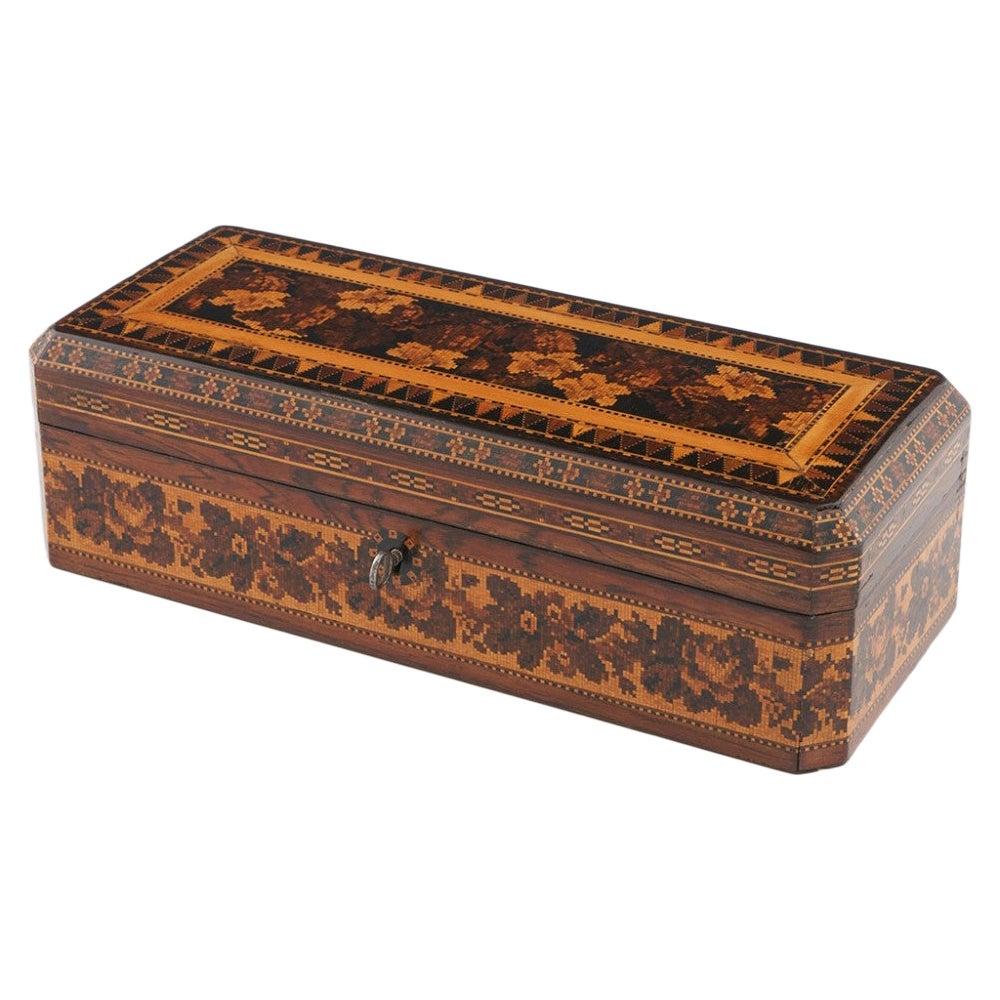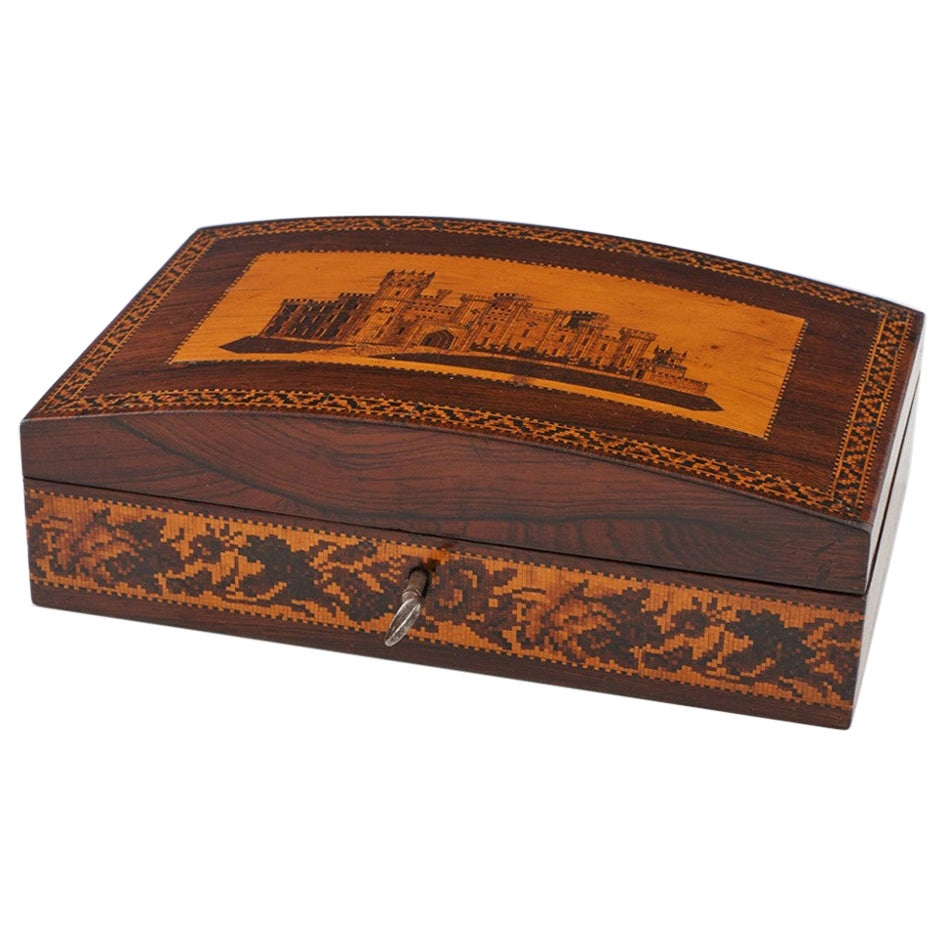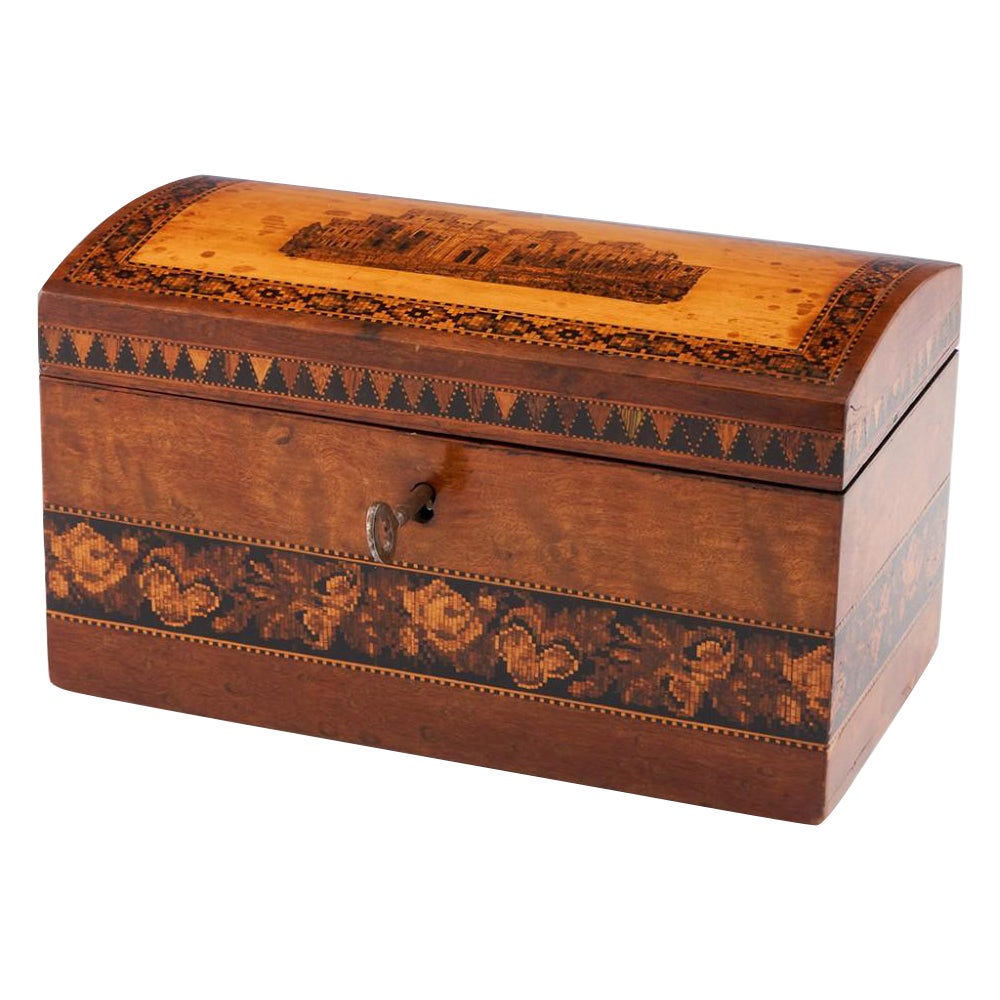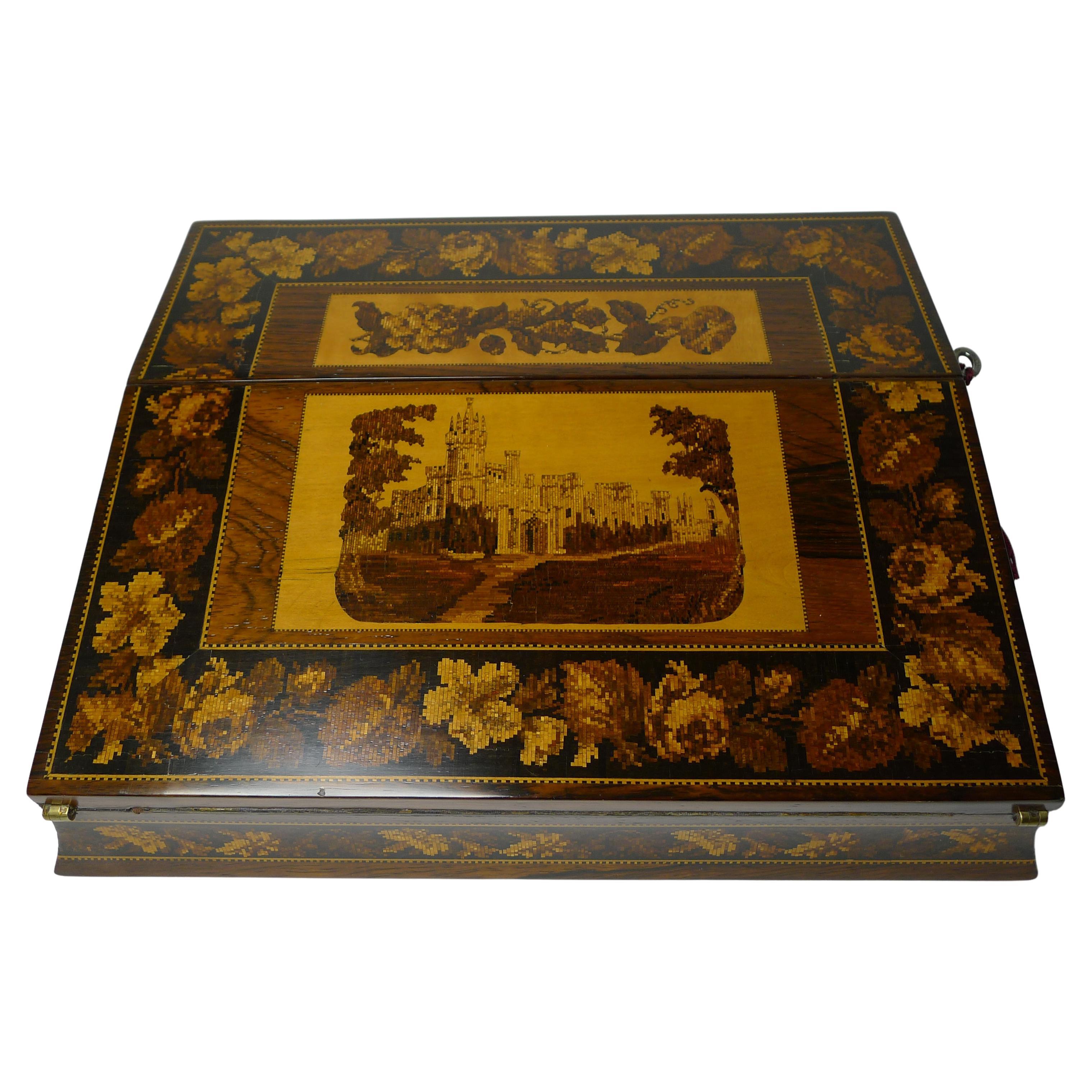Items Similar to Tunbridge Ware Sewing Box with Eridge Castle Topographic Mosaic, c1860
Want more images or videos?
Request additional images or videos from the seller
1 of 11
Tunbridge Ware Sewing Box with Eridge Castle Topographic Mosaic, c1860
About the Item
Tunbridge Ware Sewing Box with Eridge Castle Topographic Mosaic, c1860
Additional Information:
Heading: Tunbridge Ware - A Sewing Box with Eridge Castle Topographic Mosaic
Date : c1860
Period : Victorian
Origin : Tunbridge Wells; England
Decoration : Top of the lid features one of Henry Hollamby's Eridge Castle mosaics set in to a golden satinwood reserver and with a multi-coloured key-line string border; there is a somewhat stylised 20mm floral frieze around the edges of the lid's top face with a pair of banded and continuous key-lines; the front face of the body - and that of the lid - have an eight-square geometric border of a triangular pattern, set within the same two pairs of key-lines; internally, the lid is lined with original pale-blue satin; there is a lift-out tray which would have originally had twenty separate compartments, but five of the dividers are missing; two compartments have side-ledges fitted on which there would have been a lift-out lid - these too are missing; there is a shaped 'thimble rest' affixed inside one of them; the large central well, below the tray, is empty, and both this and the tray have white textured lining paper and silver paint to the vertical sides of the compartments; the whole tray is bounded with a canted piano-banded edging; to the base, textured black lining paper; working lock and key which have a flush, circular stick-ware escutcheon.
Size : 25.7 W x 18.0 D x 10.3 H cm
Condition : Very good; little or no damage other than the missing dividers as above; the base is split - but stable - right across its width; there are a number of bumps and bruises, and some surface scratches - which are entirely commensurate with age
Restoration : looks as if there has been a small replacement sliver of veneer fitted to one corner of the lid at some point, but this may well be of some considerable age
Notes : this is one of Henry Hollamby's standard mosaics, as identified by Howard Rockley in his book Topographical Tunbridge Ware; however, it's known that Hollamby supplied other manufacturers with his images so that they could be applied to their own work. This box can be attributed to Thomas Waterman as the make-up of the inset tray is identical to another example which we have sold of the same provenance, and which is identified by association with an image in Brian Austen's authoritative Tunbridge Ware and Related European Decorative Woodwares - page 160
- Dimensions:Height: 4.06 in (10.3 cm)Width: 10.12 in (25.7 cm)Depth: 7.09 in (18 cm)
- Style:Victorian (Of the Period)
- Materials and Techniques:
- Place of Origin:
- Period:
- Date of Manufacture:circa 1860
- Condition:Replacements made. Little or no damage other than the missing dividers as above; the base is split - but stable - right across its width; there are a number of bumps and bruises, and some surface scratches - which are entirely commensurate with age.
- Seller Location:Tunbridge Wells, GB
- Reference Number:
About the Seller
5.0
Gold Seller
These expertly vetted sellers are highly rated and consistently exceed customer expectations.
Established in 2014
1stDibs seller since 2023
33 sales on 1stDibs
Typical response time: 6 hours
- ShippingRetrieving quote...Ships From: Tunbridge Wells, United Kingdom
- Return PolicyA return for this item may be initiated within 30 days of delivery.
More From This SellerView All
- Eridge Castle Tunbridge Ware Tea Caddy c1860By Henry HollambyLocated in Tunbridge Wells, GBHeading : Two compartment Tunbridge ware tea caddy Date : c1860 Period : Victoria Origin : Tunbridge Wells, Kent Decoration : The cover decorated with Hollamby's version of Eridge Ca...Category
Antique 1860s British Victorian Tea Caddies
MaterialsWood
- Tunbridge Ware Glove Box c1860By Tunbridge WareLocated in Tunbridge Wells, GBHeading : Tunbridge ware glove box Date : c1860 Period : Victoria Origin : Tunbridge Wells, Kent Decoration : Cover with a berlin woolwork floral mosaic within keylines bordered by v...Category
Antique 1860s British Victorian Decorative Boxes
MaterialsWood
- Tunbridge Ware Jewellery Box Featuring Eridge Castle c1850By Tunbridge WareLocated in Tunbridge Wells, GBHeading : Tunbridge ware jewellery box Date : c1850 Period : Victoria Origin : Tunbridge Wells, Kent Decoration : Central image of Eridge Castle within keylines. Geometric border als...Category
Antique 1850s British Victorian Jewelry Boxes
MaterialsWood
- Tunbridge Ware - A Two Compartment Tea Caddy with Eridge Castle Mosaic, c1865Located in Tunbridge Wells, GBTunbridge Ware - A Two Compartment Tea Caddy with Eridge Castle Mosaic, c1865 Additional Information: Heading: Tunbridge Ware - A Two Compartment Tea Caddy with Eridge Castle Mosaic...Category
Antique 19th Century English Victorian Tea Caddies
MaterialsSatinwood
- Tunbridge Ware Wedge Shaped Stationery Box, c1860Located in Tunbridge Wells, GBTunbridge Ware Wedge Shaped Stationery Box, c1860 Additional Information: Heading: Tunbridge Ware - A Wedge Shaped Stationery Box Date : c1860 Period : Victorian Origin : Tunbridge ...Category
Antique 19th Century English Victorian Decorative Boxes
MaterialsSatinwood
- A Tunbridge Ware Games Box with Inlaid Marquetry Image of Eridge Castle, c1870By Henry HollambyLocated in Tunbridge Wells, GBA Tunbridge Ware Games Box with Inlaid Marquetry Image of Eridge Castle, c1870 Additional Information: Heading: Tunbridge Ware - A Games Box with Inlaid Marquetry Image of Eridge Ca...Category
Antique 19th Century English Victorian Decorative Boxes
MaterialsWood
You May Also Like
- Fine Tunbridge Ware Writing Box / Lap Desk, Eridge Castle, circa 1870Located in Bath, GBA truly fine example of a Victorian Tunbridge Ware writing box or lap desk dating to circa 1870. The central section featuring Eridge Castle, East Sussex. The box comes complete w...Category
Antique 1870s British Late Victorian Decorative Boxes
MaterialsWood
- Regency Tunbridge Ware Sewing BoxBy Tunbridge WareLocated in Northampton, GBFitted Interior & Silver Handles From our Tunbridge Ware collection, we are delighted to offer this Tunbridge Ware Sewing Box. The Sewing Bo...Category
Antique Early 19th Century British Regency Decorative Boxes
MaterialsSatinwood
- Georgian Tunbridge Ware Folk Art Cottage Sewing BoxBy Tunbridge WareLocated in Northampton, GBTunbridge Ware Folk House Sewing Box From our Sewing Box collection, we are thrilled to offer this Novelty Folk Art Cottage Sewing Box. The box of rectangular form made from Sycamor...Category
Antique Early 1800s British Georgian Decorative Boxes
MaterialsWood, Sycamore
- Tunbridge Ware BoxLocated in Dallas, TXLarge Tunbridge ware box with herringbone pattern inlaid parquetry. Circa 1840, England.Category
Antique 1840s English Decorative Boxes
MaterialsWood
- Brighton Pavilion Tunbridge Ware Sewing CompendiumBy Tunbridge WareLocated in Northampton, GBRare Tunbridge Ware Form Sewing Compendium From our Tunbridge Ware collection, we are delighted to offer this very rare Tunbridge Wear Sewing Compendium. The Sewing Compendium modelled as a tower from the Brighton Pavilion features the iconic minaret turned in Sycamore (aka white wood) and a large globular body with hand-painted details leading to further turned faces and the hand-painted windows upon a stepped base. The Sewing Compendium opens in two locations one just below the first dome revealing a pin cushion and the second just above the windows revealing the Sewing tools including a Tunbridge Ware thimble and bobbin. The Tunbridge Ware Sewing Compendium dates to the Georgian era during the reign of George IV circa 1825. Brighton Pavilion, The Royal Pavilion and surrounding gardens are a Grade I listed property and were the former Royal residence located in Brighton, England. It was built in 1787 in three stages as a seaside retreat for George, Prince of Wales who became the Prince Regent in 1811 and then King George IV in 1820. It is built in the Indo-Saracenic style prevalent in India for most of the 19th century. The current appearance of the Pavilion which has various domes and minarets, is the work of architect John Nash, who extended the building starting in 1815. George IV's successors William IV and Victoria also used the Pavilion but Queen Victoria decided that Osborne House should replace the Pavilion as the royal seaside retreat and therefore the Pavilion was sold to the city of Brighton in 1850. Indo-Sarascenic refers to a cross between Indian architecture and Muslim architecture. Minarets means beacon in Arabic. In Islamic religious architecture, the tower from which the faithful are called to prayer five times each day by a muezzin, or crier. Such a tower is connected to a mosque and has one or more balconies or open galleries. The inspiration for the minarets features on the Brighton Pavilion are in homage to these types of finials. John Nash (1752-1835) was one of the most prevalent British architects from the Georgian and Regency periods. He was responsible for the design, in the neoclassical and picturesque styles of many important areas of London. He was financed by the Prince Regent and by the era's most successful property developer, James Burton. Nash's most famous designs were the Brighton Pavilion, Marble Arch and Buckingham Palace. Sycamore is a member of the Maple family, found in Europe. It is light yellow in colour and is often a very clean wood, with a straight, fine grain. The wood is often pippy. However, these pips are usually a very similar colour to the rest of the wood making them hardly visible. Georgian, a period in British history dating from 1714-1837, the Georgian era after the Hanoverian kings George I, George II, George III and George IV. Tunbridge Ware Tunbridge Wells and Tunbridge in Kent, England became popular in the 17th Century for their therapeutic waters. By the 18th century, Tunbridge Wells was a hugely popular Spa resort. Shops and stalls were set up to sell local work of distinction to visitors as souvenirs. Many of the original boxes were decorated with all sorts of different kinds of designs. Many of the Tunbridge boxes...Category
Antique Early 19th Century British George IV Decorative Boxes
MaterialsWood, Sycamore
- Lovely antique Victorian tunbridge ware inlaid writing boxLocated in Ipswich, GBLovely antique Victorian tunbridge ware inlaid writing box having a lovely antique Victorian tunbridge ware inlaid wring box with beautiful detail to the box opening to reveal a pull...Category
Antique Early 19th Century Victorian Decorative Boxes
MaterialsWood
Recently Viewed
View AllMore Ways To Browse
Bohemian Glass Casket
Armor Plates Portugal
Silverware Box Gorham
Chase Reimann
Harden Bedroom Furniture Brass Handles
Lonka Lonka
Gold And Wood Box
Vizagapatam Ivory
Lucite And Chrome Box
English Chinoiserie Box
Bronze Box
Alessandro Mandruzzato Murano Glass Box
Russian Paper Mache Box
18th Century Bible Box
Porphyry Box
Singing Bird Box Automaton
Poker Chips Clay
Red Mother Of Pearl Vanity





